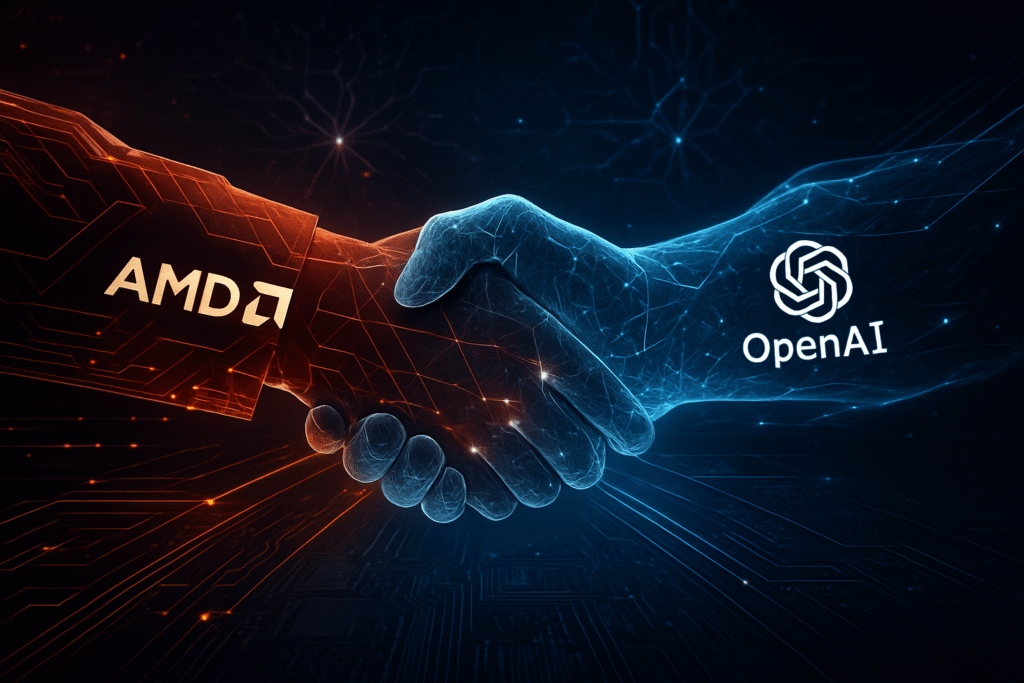
SANTA CLARA, Calif. & SAN FRANCISCO, Calif. – October 6, 2025 – In a move set to redefine the competitive landscape of artificial intelligence, Advanced Micro Devices (NASDAQ: AMD) and OpenAI today announced a landmark multi-year strategic partnership. This monumental agreement will see OpenAI deploy up to six gigawatts (GW) of AMD's high-performance Instinct GPUs to power its next-generation AI infrastructure, marking a decisive shift in the industry's reliance on a diversified hardware supply chain. The collaboration, which builds upon existing technical work, extends to future generations of AMD's AI accelerators and rack-scale solutions, promising to accelerate the pace of AI development and deployment on an unprecedented scale.
The partnership's immediate significance is profound for both entities and the broader AI ecosystem. For AMD, it represents a transformative validation of its Instinct GPU roadmap and its open-source ROCm software platform, firmly establishing the company as a formidable challenger to NVIDIA's long-held dominance in AI chips. The deal is expected to generate tens of billions of dollars in revenue for AMD, with some projections reaching over $100 billion in new revenue over four years. For OpenAI, this alliance secures a massive and diversified supply of cutting-edge AI compute, essential for its ambitious goals of building increasingly complex AI models and democratizing access to advanced AI. The agreement also includes a unique equity warrant structure, allowing OpenAI to acquire up to 160 million shares of AMD common stock, aligning the financial interests of both companies as OpenAI's infrastructure scales.
Technical Prowess and Strategic Differentiation
The core of this transformative partnership lies in AMD's commitment to delivering state-of-the-art AI accelerators, beginning with the Instinct MI450 series GPUs. The initial phase of deployment, slated for the second half of 2026, will involve a one-gigawatt cluster powered by these new chips. The MI450 series, built on AMD's "CDNA Next" architecture and leveraging advanced 3nm-class TSMC (NYSE: TSM) process technology, is engineered for extreme-scale AI applications, particularly large language models (LLMs) and distributed inference tasks.
Preliminary specifications for the MI450 highlight its ambition: up to 432GB of HBM4 memory per GPU, projected to offer 50% more HBM capacity than NVIDIA's (NASDAQ: NVDA) next-generation Vera Rubin superchip, and an impressive 19.6 TB/s to 20 TB/s of HBM memory bandwidth. In terms of compute performance, the MI450 aims for upwards of 40 PetaFLOPS of FP4 capacity and 20 PetaFLOPS of FP8 performance per GPU, with AMD boldly claiming leadership in both AI training and inference. The rack-scale MI450X IF128 system, featuring 128 GPUs, is projected to deliver a combined 6,400 PetaFLOPS of FP4 compute. This represents a significant leap from previous AMD generations like the MI300X, which offered 192GB of HBM3. The MI450's focus on integrated rack-scale solutions, codenamed "Helios," incorporating future EPYC CPUs, Instinct MI400 GPUs, and next-generation Pensando networking, signifies a comprehensive approach to AI infrastructure design.
This technical roadmap directly challenges NVIDIA's entrenched dominance. While NVIDIA's CUDA ecosystem has been a significant barrier to entry, AMD's rapidly maturing ROCm software stack, now bolstered by direct collaboration with OpenAI, is closing the gap. Industry experts view the MI450 as AMD's "no asterisk generation," a confident assertion of its ability to compete head-on with NVIDIA's H100, H200, and upcoming Blackwell and Vera Rubin architectures. Initial reactions from the AI research community have been overwhelmingly positive, hailing the partnership as a transformative move that will foster increased competition and accelerate AI development by providing a viable, scalable alternative to NVIDIA's hardware.
Reshaping the AI Competitive Landscape
The AMD-OpenAI partnership sends shockwaves across the entire AI industry, significantly altering the competitive dynamics for chip manufacturers, tech giants, and burgeoning AI startups.
For AMD (NASDAQ: AMD), this deal is nothing short of a triumph. It secures a marquee customer in OpenAI, guarantees a substantial revenue stream, and validates its multi-year investment in the Instinct GPU line. The deep technical collaboration inherent in the partnership will accelerate the development and optimization of AMD's hardware and software, particularly its ROCm stack, making it a more attractive platform for AI developers. This strategic win positions AMD as a genuine contender against NVIDIA (NASDAQ: NVDA), moving the AI chip market from a near-monopoly to a more diversified and competitive ecosystem.
OpenAI stands to gain immense strategic advantages. By diversifying its hardware supply beyond a single vendor, it enhances supply chain resilience and secures the vast compute capacity necessary to push the boundaries of AI research and deployment. The unique equity warrant structure transforms OpenAI from a mere customer into a co-investor, aligning its long-term success directly with AMD's, and providing a potential self-funding mechanism for future GPU purchases. This move also grants OpenAI direct influence over future AMD chip designs, ensuring they are optimized for its evolving AI needs.
NVIDIA, while still holding a dominant position and having its own substantial deal with OpenAI, will face intensified competition. This partnership will necessitate a strategic recalibration, likely accelerating NVIDIA's own product roadmap and emphasizing its integrated CUDA software ecosystem as a key differentiator. However, the sheer scale of AI compute demand suggests that the market is large enough to support multiple major players, though NVIDIA's market share may see some adjustments. Other tech giants like Google (NASDAQ: GOOGL), Microsoft (NASDAQ: MSFT), and Meta (NASDAQ: META) will also feel the ripple effects. Microsoft, a major backer of OpenAI and user of AMD's MI300 series in Azure, implicitly benefits from OpenAI's enhanced compute options. Meta, already collaborating with AMD, sees its strategic choices validated. The deal also opens doors for other chip designers and AI hardware startups, as the industry seeks further diversification.
Wider Significance and AI's Grand Trajectory
This landmark deal between AMD and OpenAI transcends a mere commercial agreement; it is a pivotal moment in the broader narrative of artificial intelligence. It underscores several critical trends shaping the AI landscape and highlights both the immense promise and potential pitfalls of this technological revolution.
Firstly, the partnership firmly establishes the trend of diversification in the AI hardware supply chain. For too long, the AI industry's reliance on a single dominant GPU vendor presented significant risks. OpenAI's move to embrace AMD as a core strategic partner signals a mature industry recognizing the need for resilience, competition, and innovation across its foundational infrastructure. This diversification is not just about mitigating risk; it's about fostering an environment where multiple hardware architectures and software ecosystems can thrive, ultimately accelerating the pace of AI development.
Secondly, the scale of the commitment—up to six gigawatts of computing power—highlights the insatiable demand for AI compute. This colossal infrastructure buildout, equivalent to the energy needs of millions of households, underscores that the next era of AI will be defined not just by algorithmic breakthroughs but by the sheer industrial scale of its underlying compute. This voracious appetite for power, however, brings significant environmental concerns. The energy consumption of AI data centers is rapidly escalating, posing challenges for sustainable development and intensifying the search for more energy-efficient hardware and operational practices.
The deal also marks a new phase in strategic partnerships and vertical integration. OpenAI's decision to take a potential equity stake in AMD transforms a traditional customer-supplier relationship into a deeply aligned strategic venture. This model, where AI developers actively shape and co-invest in their hardware providers, is becoming a hallmark of the capital-intensive AI infrastructure race. It mirrors similar efforts by Google with its TPUs and Meta's collaborations, signifying a shift towards custom-tailored hardware solutions for optimal AI performance.
Comparing this to previous AI milestones, the AMD-OpenAI deal is akin to the early days of the personal computer or internet revolutions, where foundational infrastructure decisions profoundly shaped subsequent innovation. Just as the widespread availability of microprocessors and networking protocols democratized computing, this diversification of high-performance AI accelerators could unlock new avenues for AI research and application development that were previously constrained by compute availability or vendor lock-in. It's a testament to the industry's rapid maturation, moving beyond theoretical breakthroughs to focus on the industrial-scale engineering required to bring AI to its full potential.
The Road Ahead: Future Developments and Challenges
The strategic alliance between AMD and OpenAI sets the stage for a dynamic future, with expected near-term and long-term developments poised to reshape the AI industry.
In the near term, AMD anticipates a substantial boost to its revenue, with initial deployments of the Instinct MI450 series and rack-scale AI solutions scheduled for the second half of 2026. This immediate validation will likely accelerate AMD's product roadmap and enhance its market position. OpenAI, meanwhile, gains crucial compute capacity, enabling it to scale its next-generation AI models more rapidly and efficiently. The direct collaboration on hardware and software optimization will lead to significant advancements in AMD's ROCm ecosystem, making it a more robust and attractive platform for AI developers.
Looking further into the long term, the partnership is expected to drive deep, multi-generational hardware and software collaboration, ensuring that AMD's future AI chips are precisely tailored to OpenAI's evolving needs. This could lead to breakthroughs in specialized AI architectures and more efficient processing of increasingly complex models. The potential equity stake for OpenAI in AMD creates a symbiotic relationship, aligning their financial futures and fostering sustained innovation. For the broader AI industry, this deal heralds an era of intensified competition and diversification in the AI chip market, potentially leading to more competitive pricing and a wider array of hardware options for AI development and deployment.
Potential applications and use cases on the horizon are vast. The enhanced computing power will enable OpenAI to develop and train even larger and more sophisticated AI models, pushing the boundaries of natural language understanding, generative AI, robotics, and scientific discovery. Efficient inference capabilities will allow these advanced models to be deployed at scale, powering a new generation of AI-driven products and services across industries, from personalized assistants to autonomous systems and advanced medical diagnostics.
However, significant challenges need to be addressed. The sheer scale of deploying six gigawatts of compute capacity will strain global supply chains for advanced semiconductors, particularly for cutting-edge nodes, high-bandwidth memory (HBM), and advanced packaging. Infrastructure requirements, including massive investments in power, cooling, and data center real estate, will also be formidable. While ROCm is maturing, bridging the gap with NVIDIA's established CUDA ecosystem remains a software challenge requiring continuous investment and optimization. Furthermore, the immense financial outlay for such an infrastructure buildout raises questions about long-term financing and execution risks for all parties involved.
Experts largely predict this deal will be a "game changer" for AMD, validating its technology as a competitive alternative. They emphasize that the AI market is large enough to support multiple major players and that OpenAI's strategy is fundamentally about diversifying its compute infrastructure for resilience and flexibility. Sam Altman, OpenAI CEO, has consistently highlighted that securing sufficient computing power is the primary constraint on AI's progress, underscoring the critical importance of partnerships like this.
A New Chapter in AI's Compute Story
The multi-year, multi-generational deal between AMD (NASDAQ: AMD) and OpenAI represents a pivotal moment in the history of artificial intelligence. It is a resounding affirmation of AMD's growing prowess in high-performance computing and a strategic masterstroke by OpenAI to secure and diversify its foundational AI infrastructure.
The key takeaways are clear: OpenAI is committed to a multi-vendor approach for its colossal compute needs, AMD is now a central player in the AI chip arms race, and the industry is entering an era of unprecedented investment in AI hardware. The unique equity alignment between the two companies signifies a deeper, more collaborative model for financing and developing critical AI infrastructure. This partnership is not just about chips; it's about shaping the future trajectory of AI itself.
This development's significance in AI history cannot be overstated. It marks a decisive challenge to the long-standing dominance of a single vendor in AI accelerators, fostering a more competitive and innovative environment. It underscores the transition of AI from a nascent research field to an industrial-scale endeavor requiring continent-level compute resources. The sheer scale of this infrastructure buildout, coupled with the strategic alignment of a leading AI developer and a major chip manufacturer, sets a new benchmark for how AI will be built and deployed.
Looking at the long-term impact, this partnership is poised to accelerate innovation, enhance supply chain resilience, and potentially democratize access to advanced AI capabilities by fostering a more diverse hardware ecosystem. The continuous optimization of AMD's ROCm software stack, driven by OpenAI's demanding workloads, will be critical to its success and wider adoption.
In the coming weeks and months, industry watchers will be keenly observing further details on the financial implications, specific deployment milestones, and how this alliance influences the broader competitive dynamics. NVIDIA's (NASDAQ: NVDA) strategic responses, the continued development of AMD's Instinct GPUs, and the practical implementation of OpenAI's AI infrastructure buildout will all be critical indicators of the long-term success and transformative power of this landmark deal. The future of AI compute just got a lot more interesting.
This content is intended for informational purposes only and represents analysis of current AI developments.
TokenRing AI delivers enterprise-grade solutions for multi-agent AI workflow orchestration, AI-powered development tools, and seamless remote collaboration platforms. For more information, visit https://www.tokenring.ai/.






